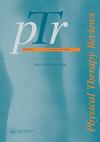Effectiveness of action observation therapy on upper extremity function in children with cerebral palsy: systematic review and meta-analysis
IF 0.8
Q4 REHABILITATION
引用次数: 0
Abstract
Abstract Background Action observation therapy is a novel rehabilitation tool. It is a top-down approach based on mirror neuron system recruitment. Objectives To evaluate action observation therapy’s effectiveness in improving upper limb function in children with cerebral palsy and perform a meta-analysis to synthesize data across statistically similar studies. Methods Data Sources: Included The Web of Science, Science Direct, OVID, PubMed, Physiotherapy Evidence Database PEDro, and the Cochrane Library. Study selection: The authors included randomized controlled trials that studied the effect of action observation therapy alone or associated with other treatment methods on upper limb function in children with cerebral palsy. Five studies met the inclusion criteria. Study appraisal: Two authors extracted data independently and assessed the risk of bias using The Cochrane Collaboration tool for assessing the risk of bias in randomized trials. Results Of the five studies chosen for review, we included three in the meta-analysis. There was no significant difference between action observation therapy with repeated action versus repeated action alone in the hand assessment (AHA) scale, the Melbourne Assessment of Unilateral Upper Limb (MUUL), and ABILHAND- Kids (P-values 0.53, 0.26, 0.89, respectively). Conclusions Action observation therapy has no advantage over traditional functional motor training in improving upper limb function in rehabilitating children with cerebral palsy.动作观察疗法对脑瘫患儿上肢功能的影响:系统评价与meta分析
背景动作观察疗法是一种新型的康复手段。这是一种基于镜像神经元系统招募的自上而下的方法。目的评价动作观察疗法改善脑瘫患儿上肢功能的有效性,并进行meta分析,综合统计相似研究的数据。方法数据来源:Web of Science, Science Direct, OVID, PubMed, physical therapy Evidence Database PEDro, Cochrane Library。研究选择:作者纳入随机对照试验,研究单独或联合其他治疗方法对脑瘫儿童上肢功能的影响。5项研究符合纳入标准。研究评估:两位作者独立提取数据,并使用Cochrane协作工具评估随机试验的偏倚风险。结果在入选的5项研究中,我们纳入了3项荟萃分析。在手部评估(AHA)量表、单侧上肢墨尔本评估(MUUL)量表和ABILHAND- Kids量表上,重复动作观察疗法与单独重复动作疗法比较,差异均无统计学意义(p值分别为0.53、0.26、0.89)。结论动作观察疗法在改善脑瘫患儿上肢功能方面没有传统功能运动训练的优势。
本文章由计算机程序翻译,如有差异,请以英文原文为准。
求助全文
约1分钟内获得全文
求助全文
来源期刊

Physical Therapy Reviews
REHABILITATION-
CiteScore
1.30
自引率
0.00%
发文量
26
期刊介绍:
Physical Therapy Reviews is an international journal which aims to publish contemporary reviews, discussion papers and editorials within physical therapy, and in those basic and clinical sciences which are the basis of physical therapy. The journal is aimed at all those involved in research, teaching and practice within the area of physical therapy. Reviews (both descriptive and systematic) are invited in the following areas, which reflect the breadth and diversity of practice within physical therapy: •neurological rehabilitation •movement and exercise •orthopaedics and rheumatology •manual therapy and massage •sports medicine •measurement •chest physiotherapy •electrotherapeutics •obstetrics and gynaecology •complementary therapies •professional issues •musculoskeletal rehabilitation
 求助内容:
求助内容: 应助结果提醒方式:
应助结果提醒方式:


